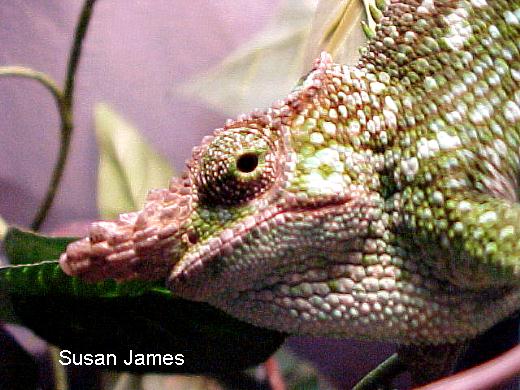B. f. multituberculatum: The rostral process is wider at the base and has a rounded tip. The upper rim has a serrated appearance and the dorsal crest has pronounced tubercular scales, decreasing in size caudally. Females have small, round horn buds and pronounced scales on the on the dorsum that extend to the middle of the body.
B. f. multituberculatum is endemic to the eastern Usambara Mountains of Tanzania and has been reported to have higher hydration requirements than some other subspecies. They are smaller than the nominate form.
Contributed by S. James and E. Pollak
References
Bartlett, R. D. and Bartlett, P.
1995. Chameleons: A Complete
Pet Owner's Manual. Barron's
Educations Series, Hauppuage, NY
Davison, Linda J. 1997. Chameleons:
Their Care and Breeding.
Hancock House Publishers,
Blaine, WA
Klaver, C. & W. Boehme.
1997. Chamaeleonidae. Das
Tierreich, 112: i-xiv' 1 -
85. Verlag Walter de Gruyter
& Co., Berlin, New York.
Le Berre, F. 1994. The New
Chameleon Handbook. Barron's
Educational Series.
Martin, J., 1992. Masters of
Disguise: A Natural History of
Chameleons. Facts On File,
Inc., New York, NY.
Necas, P. 1999. Chameleons:
Nature's Hidden Jewels.
Krieger Publishing Company,
Malabar, FL.
Schmidt, W., Tamm, K. and
Wallikewitz, E. 1994a. Chameleons,
Volume I: Species. T.F.H.
Publications, Neptune City, NJ.
Schmidt, W., Tamm, K. and
Wallikewitz, 1994b. Chameleons,
Volume II: Care and Breeding. T.F.H. Publications, Neptune City, NJ.
Spawls,
S., Howell, K., Drewes, R., and
Ashe, J. 2002. A Field Guide
to the Reptiles of East Africa. Academic Press, New York.


